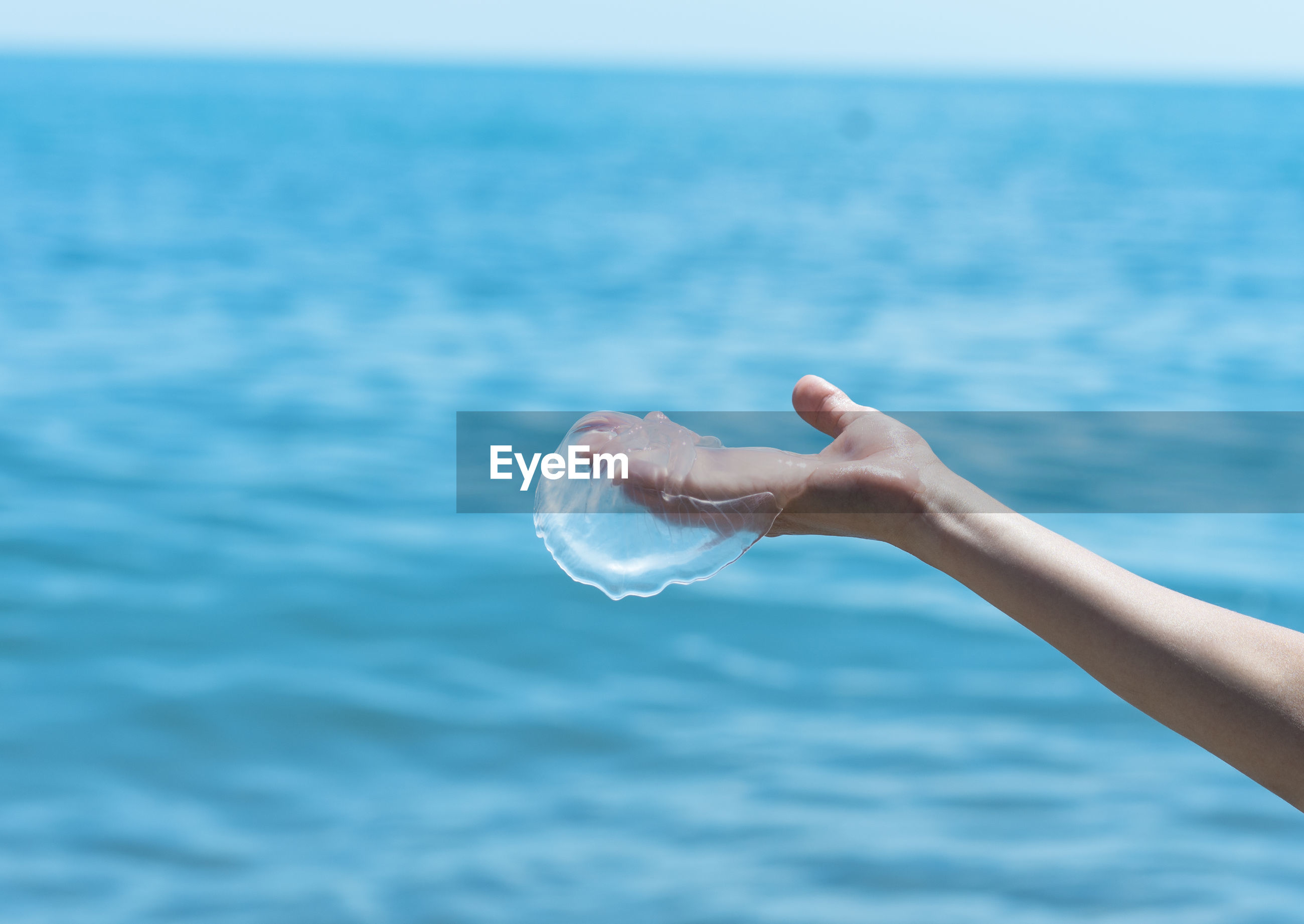
Jellyfish Stock Image Image 7185901
Jellyfish have special cells along their tentacles called. It's good to have this information in-hand when you go to the beach just in case—though it's unlikely that you'll be stung..

Jellyfish in boy s hands stock image. Image of underwater 44090509
Chironex fleckeri, commonly known as the Australian box jelly, and nicknamed the sea wasp, is a species of extremely venomous box jellyfish found in coastal waters from northern Australia and New Guinea to Indonesia, Cambodia, Malaysia and Singapore, the Philippines and Vietnam. [1]

Jellyfish in hand stock image. Image of human, water 20305801
Jellyfish, also known sea jellies, are the medusa-phase of certain gelatinous members of the subphylum Medusozoa, which is a major part of the phylum Cnidaria.. many of these tiny creeping jellyfish cannot be seen in the field without a hand lens or microscope.

Jellyfish in hand stock image. Image of wildlife, hand 20305801
Clean the net thoroughly after using. If a net is not available, wet a T-shirt and pick up the jellyfish with the T-shirt wrapped around your hand. Because the jellyfish will be incredibly slippery, this is not an ideal way to pick it up, but will work if no other options are available. Throw away the T-shirt after using.

A Man Holds a Jellyfish in His Hand Stock Image Image of rescue, spring 175577045
Clear and transparent Around 5cm to 40cm wide Saucer-shaped umbrella head Short, stinging tentacles and gonads in four circles Four long oral arms Abundant in most oceans and coastal waters Can withstand freezing water (up to -6 degrees Celsius)

Jellyfish in hand. stock image. Image of water, creature 33280169
The bell of the moon jellyfish is ringed with many fine tentacles. Among their many tentacles, some jellyfish have parts known as oral arms. These long appendages move captured prey to the animal's mouth, which is usually found on the underside of the bell. Some species have even ditched a mouth entirely. These jellies ingest food directly.

Jellyfish in the hands stock image. Image of blue, female 34980287
Moon jellyfish are considered a delectable snack by all sorts of turtles, birds and fish. Their clear gelatinous structure might not look nutritious, but moon jellyfish contain some fatty acids crucial to growth and reproduction. Plus, they are pretty slow, making it easy for their predators to have a lazy afternoon lunch.

Free Images hand, beach, jellyfish, invertebrate, close up, florida, macro photography
Additional Resources. Jellyfish and comb jellies are gelatinous animals that drift through the ocean's water column around the world. They are both beautiful—the jellyfish with their pulsating bells and long, trailing tentacles, and the comb jellies with their paddling combs generating rainbow-like colors. Yet though they look similar in some.

Jellyfish in the hands stock image. Image of teen, happiness 34980283
They identified how the stinging cells, called nematocytes, which are found along the tentacles of sea anemones and jellyfish — both types of cnidaria — detect and filter diverse cues from the environment to control when (and when not) to sting. The researchers found that nematocyte cells from the starlet sea anemone, a relation of the.

Cropped image of hand holding jellyfish ID 108512314
Overview What is a jellyfish sting? Jellyfish are sea creatures that live in all of the world's oceans. They have soft, bell-shaped bodies with lengthy, finger-like structures called tentacles. Jellyfish have stinging cells called nematocysts inside of their tentacles. A single tentacle may contain thousands of nematocysts.

Boy holding jellyfish stock image. Image of positivity 6011871
Dr Gershwin notes that jellyfish bloom increases go hand in hand with ecosystem degradation. "Overfishing, a rise in water temperature, high mineralisation and a reduction in number of pelagic fish [jellyfish predators] are creating a perfect environment for jellyfish to bloom. They flourish in dead zones where other creatures can't survive.

Moon jellyfish stock photo. Image of handheld, jelly 41901264
After the eggs of the female jellyfish are fertilized by the male's sperm, they undergo the embryonic development typical of all animals. They soon hatch, and free-swimming "planula" larvae emerge from the female's mouth or brood pouch and set out on their own. A planula is a tiny oval structure the outer layer of which is lined with minute.

A Freshwater Jellyfish Being Held in Hand Stock Image Image of jelly, hand 95909633
The most important helping hand for jellyfish may be overfishing. In one well-documented episode, the devastation of sardine stocks appear to have cleared the way for the rise of Chrysaora off Namibia, in waters known as the northern Benguela. Recent research cruises there have hauled in about four times as much jelly biomass as fish biomass.

Jellyfish in the Children Hands Stock Photo Image of beach, travel 124704278
Overview Jellyfish stings are fairly common problems for people swimming, wading or diving in oceans. The long tentacles trailing from the jellyfish can inject venom from thousands of microscopic barbed stingers. Most often jellyfish stings cause instant pain and inflamed marks on the skin. Some stings may cause more whole-body (systemic) illness.

Jellyfish Cornerot Rhizostoma Pulmo. a Small Jellyfish in the Hand. Stock Photo Image of
Most jellyfish stings are painful but not dangerous. A few jellyfish, however, release powerful venom into the skin. The stings of these species, if left untreated, can be dangerous or even deadly.

Jellyfish in hand. stock image. Image of water, creature 33280169
View from above on a child hand touching the bell of a purple jellyfish swimming in the sea near the beach. A child standing knee-deep in sea water touches carefully a jellyfish from above. Happy African-American boy celebrates birthday by holding a chocolate cake in his hands with candles and enjoying holiday on yellow torn paper background.